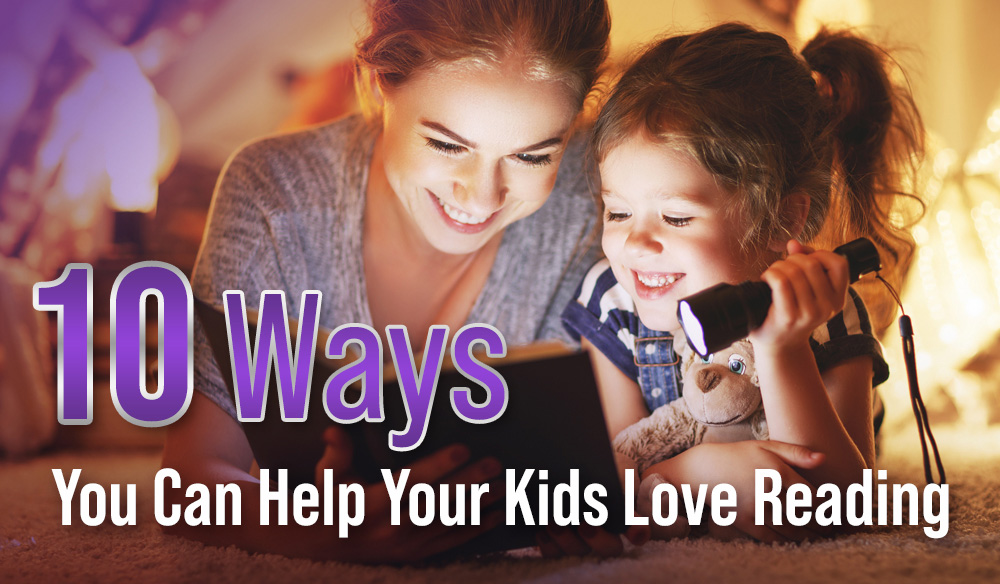10 Ways You Can Help Your Kids Love Reading
Are you a reader?
Between carpool lines and soccer practice, school or job responsibilities, laundry, and getting dinner on the table – no judgment here.
In some seasons, it feels almost impossible to find a break in the schedule to indulge in the relaxing escape of a gripping tale. Whether you are an avid reader now, many of us have fond memories of getting lost in the pages of a book.
This week, we are celebrating literature with ten ways to help your kids love reading.
But first, how about a quiz?
Can you identify each classic title simply from the opening line?
- Once there were four children whose names were Peter, Susan, Edmund, and Lucy.
- “Christmas won’t be Christmas without any presents,” grumbled Jo, lying on the rug.
- “Where’s Papa going with that ax?” said Fern to her mother as they were setting the table for breakfast.
- Marley was dead, to begin with.
- There is no lake at Camp Green Lake.
- “TOM!” No answer. “TOM!” No answer. “What’s gone with that boy, I wonder?
- When Mary Lennox was sent to Misselthwaite Manor to live with her uncle, everybody said she was the most disagreeable-looking child ever seen.
How did you do? I’ll bet you knew more than a few. The answers, in order, are The Lion, The Witch, and The Wardrobe by C.S. Lewis, Little Women by Louisa May Alcott, Charlotte’s Web by E.B. White, A Christmas Carol by Charles Dickens, Holes by Louis Sachar, The Adventures of Tom Sawyer by Mark Twain, and The Secret Garden by Frances Hodgson Burnett.
If you identified:
7 – Bibliophilic Boss. Why are you here? You have better things to read!
4-6 – Solid. You know your stuff.
1-3 – Who can tell anything from a first line anyway!?
Stories. Whether we pored over the books on our own, or our parents read them to us. They touched us and taught us, and took us on journeys to faraway adventures. When we were kids, for many of us, screens weren’t the native language of our culture like they are today. Until the advent of the smartphone in 2007, life had a different feel. Of course, in so many ways, technology has been a blessing. As moms, though, it might take a little extra effort to draw your kids back to a love of reading that will help them develop language skills, comprehension, and a vivid imagination.
Kids who read well excel in school, in their careers – and so many areas of life. The task to instill a love of reading in them can seem formidable with the many screens contending for their attention, but it is a gift – maybe one that they don’t even know they want.
Here are ten ideas that might help your kids learn to love reading:
1. Model Reading
You’ve probably seen the sage parenting quotes on social media – like “Children watch what we do more than they listen to what we say,” and variations of that thought. It’s true. We must model what we hope our children will adopt. This goes for helping them develop a love for reading.
Let your kids see you curled up with a good book. If they only ever see mom holding a screen, even if it’s a Kindle or other reading device, it’s not the same. Consider going old school and turning the pages – a more analog approach. Modeling enjoyment in reading can be a subtle cue that it’s something you value.
2. Set the Stage
Consider creating a place in the house that’s comfortable, cozy, and conducive to reading. Make it a screen-free zone with colorful books lining a bookshelf or collected in baskets. It may be a corner, or an entire room – just be sure to make it inviting so that being there is a treat.
You could even ask the kids to help you design the space. What type of seating would you like? Bookshelf or wall shelves? Colors? Will it be for the children exclusively, or will it be a place the family can gather?
3. Have Family Reading Times
When my kids were young, we gathered some evenings or mornings, and I read aloud. They loved it. Several I recall sharing with them were “Holes” by Louis Sachar, “Winnie the Pooh” by A.A. Milne, and “Anne of Green Gables” by L.M. Montgomery. (Incidentally, I wanted to include Anne in the quiz, but the first sentence of that classic has a staggering 148 words!)
Gather the family in your favorite spot to read aloud together, or set aside time when each person dives into their own book silently. You can share the time, even if you don’t share the same book. At the end of 30 minutes, or however long you choose (considering the ages of your little ones), you can take a few minutes to let each family member share a little about what they read.
Consider asking questions like, “What was your book about?” or “What happened in the chapter you just finished?” “Who is your favorite character in the story, and what do you like about them?”
4. Let Your Kids Name Their Adventure
Allow your children to choose books they are interested in. Spoiler alert – they may not gravitate to the classics, much as we’d love them to!
Plan regular trips to the library and teach them how to search for books on topics like sports, art, humor, architecture, cooking, weather, history, bugs, astronauts, or trains. Let them discover stories they love, and if they’re young, picture books that capture their imagination.
Make it a planned outing every couple of weeks or once a month. Library trips can be fun and anticipated adventures for kids as they bring back the books they’ve finished and pick out a whole new batch!
5. Make Reading a Reward – Not a Penalty
If you like to reward your children for completing chore charts or earning good grades, a great way to celebrate their accomplishments is to visit a bookstore to let them pick out a new book.Remember to speak about reading in favorable terms, and never use it as a form of punishment. For example, if your child misbehaves, time spent reading should not be the penalty.
Instead, if your child dreads going to bed and wants to stay up longer, why not grant them extra time in bed to read before lights out? That allows them to stay up later (what they wanted), enjoying a book (what you hoped for). It’s also a great way to transition to sleep, as reading can be a calming activity.
6. Consider Age and Attention Span
Young children, such as those aged 4-6 years old, generally enjoy picture books that are shorter and less complex than the chapter books their 8- to 12-year-old siblings are reading. They may not be ready for a rigorous 30 minutes of reading – let alone a “family reading HOUR.” It’s a lot for a little one to stay still for.
Lengthen the time spent reading as your kids get older. Encourage reading and be attuned to how much is enjoyable and sustainable for your child’s age, learning style, and temperament. Don’t inadvertently turn reading into a chore; instead, make it a pleasure.
7. Normalize Quiet
If your home is anything like mine, you may struggle with nonstop noise, whether it’s a TV blaring, music, or talk radio. Make sure to give yourself and your kids time when it’s just quiet and hopefully peaceful, so that when reading time comes, they are accustomed to the lack of auditory stimulation and it doesn’t feel strange to turn it all off.
8. Encourage Your Reluctant Reader
Use the tips we mentioned previously to help your reluctant reader develop a deeper appreciation for the written word. Graphic novels, silly humor, and choosing books slightly below their grade or reading level can make things easier. Shorter reading times, less strenuous material, and reading aloud to your hesitant reader can all gently encourage them toward a love for books.
Be patient. Don’t worry if it takes some extra time, and be sure to encourage and play to your child’s interests and strengths. Most often, the payoff will eventually come.
9. Use Book Series to Boost Reading
When my mom was a girl, the Nancy Drew series was all the rage. When my kids were little, the Magic Tree House books were huge. Book series with new titles released several times per year can build anticipation as your child eagerly awaits the upcoming street date for the next book in a favorite series.
A few you may have heard of are Amelia Bedelia, The Boxcar Children, and The Chronicles of Narnia. Also worth exploring are other faith-based series, such as The Wingfeather Saga, The Imagination Station books, or The Cooper Kids.
10. Reading is Good, No Matter the Style
As long as the content is safe and within appropriate boundaries, reading is beneficial. Remember this, especially if your kids tend to gravitate toward comic books or graphic novels, that’s reading too.
When I was a tween – so, so many years ago, we had comic book versions of The Cross and the Switchblade, Through Gates of Splendor, and even The Hiding Place. I also loved Archie comics. Before I learned to appreciate all kinds of books, I first read and re-read these comics as a kid.
If you’re concerned, why not read a classic book you enjoyed in your youth aloud to your kids? It’s all part of their reading journey, which will help your child grasp concepts, improve communication, and foster creativity – and could lead to higher grades!
If your family already loves a good story in front of the fireplace on a cool fall evening, great! However, if your crew isn’t quite there yet, and you want to build the value of reading for your loved ones, be patient. If screens have taken over, give yourself and your family members grace. Take it slowly and gradually cultivate the enjoyment of reading in your home. Reading is a gift you can all grow to love and will mark the lives of your children. It’s worth all the time – and every effort.
Podcast Note: Julie Lavendar, author of The Amazings series, for grades 3-5, was our guest on this week’s podcast. Join us to learn more about this incredibly creative author, musician, and teacher who endeavors to revitalize kids’ imagination through powerful and engaging stories.
***




